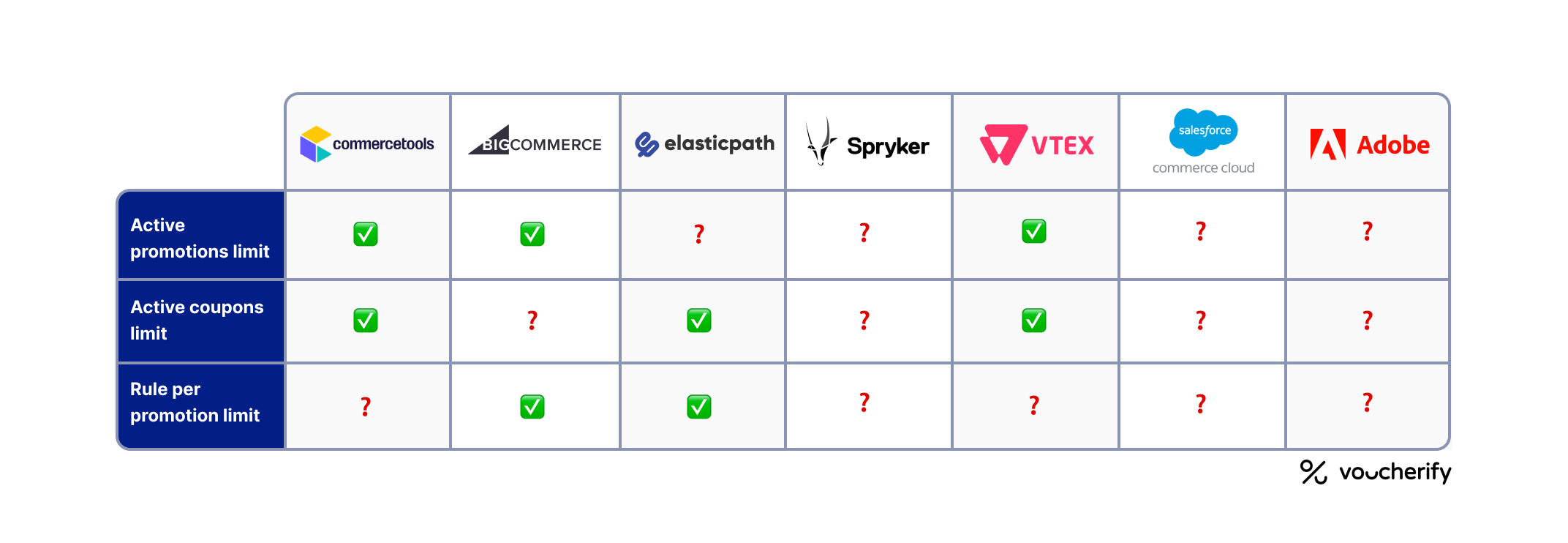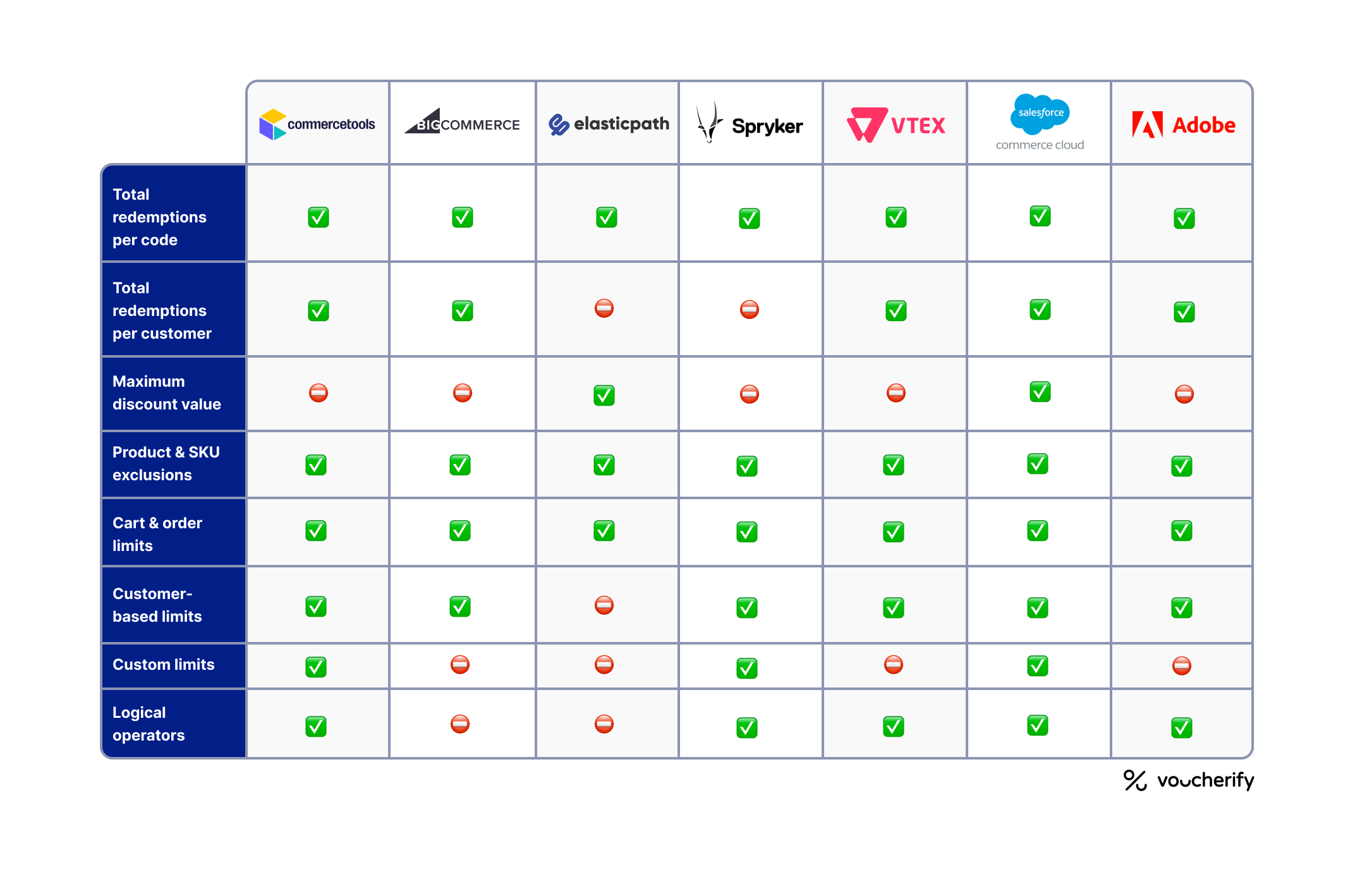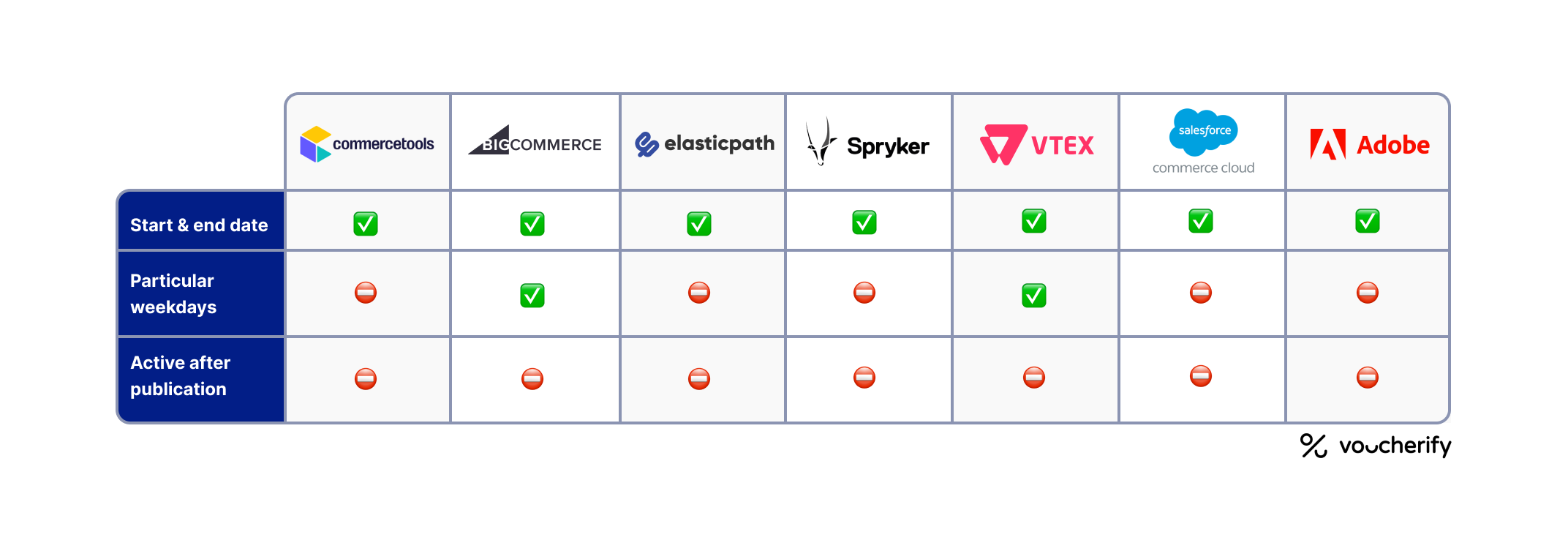
In the world of online selling, picking the right ecommerce platform is key for business success. One big factor to consider? Promotion capabilities – they’re crucial for engaging customers and boosting ROI. In this blog post, I’ll compare how the most popular ecommerce platforms like commercetools, BigCommerce, Elastic Path, Spryker, VTEX, Adobe Commerce, or Salesforce Commerce Cloud stack up in the area of promotions, coupons and loyalty programs.
Note: The following analysis is based on the publicly available documentation. If I missed or misrepresented any feature, please let me know at marketing@voucherify.io
To arm you with critical knowledge of how major ecommerce players handle promotions, I analyzed the following features:
Choosing an ecommerce platform is an enormous challenge. And more often than not, it turns out that your selected vendor does not cover all your needs, especially since ideas from business and marketing tend to pop up pretty quickly.
In the context of promotions and loyalty, luckily you can extend any ecommerce platform with Voucherify APIs. But before we get there, let’s see how key ecommerce players approach promotions.
Different promotions have different goals (boost sales, clear inventory, attract new customers). Choosing the right platform to support your campaign goals ensures you have the tools to run effective promotions and maximize your return on investment (ROI) when your promotion strategy pivots.
Here is an overview of key campaign types offered by each analyzed platform.
Note: Each platform capabilities within a specific campaign type differ. The following analysis is based on available documentation and does not take into account plug-ins and workarounds.
.png)
Category winner: Adobe Commerce (+ Magento)
In this section, I analyze the variety of discount types & effects. By making sure that your ecommerce platform supports as many discount effects as possible, you will have a wide selection of options to incentivize customers in more fulfilling ways than a simple 10% off.
.png)
Category winner: VTEX
When selecting an ecommerce platform, you need to consider account limitations that may hinder your campaigns. Here is an overview of some of them:

Category winner: commercetools
Fraud prevention and budget constraints are key to keeping promotions healthy. Here is an overview of promotion limits specifying how many times a customer can redeem a particular promotion and any products or categories excluded.

Category winner: Salesforce B2C Commerce
Being able to control the lifetime of promotions is another key building block to a successful promotional strategy. Here is how major ecommerce players handle promotion lifetime:

Category winner: VTEX
You should also check whether multiple promotions can be applied simultaneously (stacking). All ecommerce platforms can have varying rules governing the priority of different promotions when multiple apply to a single order.

Category winner: Spryker
Promotion personalization is critical if you want to see positive ROI from your campaigns. Here are some promotion targeting features found in analyzed platforms:

Category winner: commercetools
Ease of use is essential in relieving developers and giving non-technical teams control over how your promotions play out.

Category winner: VTEX
Ecommerce platforms are like jacks of all trades – they need to be able to support a range of critical commerce features, including promotions. But as jacks of all trades go, they cannot master any specific area – this is where specialized technology vendors, such as Voucherify, come into play. Here are the most common pitfalls of built-in ecommerce promotion engines and how you can overcome them by integrating Voucherify:
Most ecommerce promotion engines support only basic discounts and promotions, with no capabilities for loyalty management, cashback, advanced bundling, or referrals.
Voucherify is a one-stop shop for all types of promotional campaigns. Here are some of the most popular promotion types brands run with Voucherify:
By integrating Voucherify into your ecommerce platform, your team can effortlessly run all of these campaigns straight from the get-go, without installing external plugins or looking for costly workarounds. By connecting with Voucherify, you can extend your ecommerce platform with a ready set of best-of-breed promotional and loyalty features, without the need to code these functionalities from scratch.
Most ecommerce platforms impose rigid restrictions on the number of concurrent campaigns or generated promo codes (if they even allow it in the first place). Voucherify as a specialized solution for promotions, imposes no limits on the number of active campaigns and any other limits are fully customizable.
Most ecommerce promotion engines allow only for basic targeting based on order and product attributes – very few venture beyond default promotion conditions. Given platform complexity, plugging in CDPs and other personalization platforms to enhance the promotion experience, may also require a heavy workload for your tech team.
Voucherify's API-first approach allows you to integrate powerful targeting features regardless of your existing ecommerce platform. This provides more control and customization compared to the limitations of some built-in promotion management systems. It’s also easy to connect Voucherify with CDP or a CRM platform, such as Segment or mParticle, for enhanced promotion personalization.
For all analyzed ecommerce platforms, promotions are handled as a global entity accessible by plenty of users responsible for different stores, websites, or locations. Unauthorized access may lead to promotion fraud and leakage, not to mention overall confusion and human errors caused by this kind of setup.
With Voucherify you can build separate projects to manage promotions in safe and separate environments per brand, location, store, and more. Individual Voucherify users can access only specific projects, protecting campaigns from unauthorized access.
It is also possible to set approval workflows for specific users. It means that any campaign change performed by a specific user has to be approved by the admin.
Ecommerce platforms allow you to ship promotions only to specific storefronts across the web and mobile. If you want to use email, push, SMS, and other means of communication you need to find a workaround as there are no out-of-the-box connections to engagement platforms. With Voucherify you get a set of ready connectors to the most popular CEPs, such as Braze, MoEngage, Klaviyo, Bloomreach Engagement, and more.
Most ecommerce promotion engines lack granular promotion analytics or audit logs for troubleshooting. Without knowledge of how promotions impact your bottom line, you are left in the dark – more often than not losing money on incentives that are either unnecessary or mismatched.
Voucherify offers a set of granular analytics of redemption rates, promotion performance, 360-degree customer profiles, and audit logs with detailed API requests and responses for quick troubleshooting and support queries.
By looking at the comparison above, I am sure that perhaps you’ve been thinking about possible workarounds or custom development – and of course, you’re free to do so. However, coding promotion features from scratch requires plenty of development work and maintenance overhead. Not to mention, that if you ever decide to switch your ecommerce engine, all your coding work will go straight to the trash as custom coding excludes interoperability.
If promotions and loyalty are a critical focus for your brand, you should always think ahead and select a platform that ensures future interoperability between tools you need now and may need in the future. What’s even better is that you can integrate Voucherify iteratively before fully dropping the built-in promotion engine of your commerce platform. Just pick the APIs you need, create a separate layer to connect Voucherify with your checkout, and run the MVP in less than one spint.
Thanks to abstract REST APIs and custom objects, Voucherify can be easily integrated with any commerce platform – check our connectors with commercetools, BigCommerce, Salesforce, and more. Join global brands like Casa Shops, Breville, Munhowen Drinx, Smallable, or Colette and use Voucherify together with your ecommerce engine for the best promotional and loyalty outcomes.